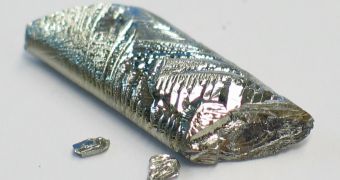A group of investigators with an international scientific collaboration announces the discovery of the rare-Earth element tellurium in three ancient stars. The objects are about 12 billion years old, meaning that they formed when the Universe was only a portion of its current age.
This investigation suggests that the semiconducting alloy was first synthesized during a very special type of supernova explosion, which usually occurs during rapid nuclear fusion reactions. It could be that most other heavy metals appeared via the same process as well.
Shortly after springing into existence, more than 13.75 billion years ago, the Universe was entirely made up of chemicals that were byproducts of the Big Bang – hydrogen, helium and some lithium.
It wasn't until 300 million years later that the first stars appeared. Inside their cores, these objects produced new, heavier chemicals. When they reached the end of the burning cycles and exploded, these stars spread the elements throughout their surroundings, from where they were recycled by other stars.
Carbon, oxygen, and iron appeared as a direct result of supernova blasts, as did most other elements in the Period Table. All stars and planets today have traces of these chemicals, since they all contain matter recycled from the first stars and supernovae.
Details of the research appear in the latest online issue of the esteemed Astrophysical Journal Letters. The team says it focused its research on three old stars located in the halo surrounding the Milky Way, just a few thousand light-years away.
“We want to understand the evolution of tellurium – and by extension any other element – from the Big Bang to today. Here on Earth, everything’s made from carbon and various other elements, and we want to understand how tellurium on Earth came about,” says Anna Frebel.
The expert holds an appointment as an assistant professor of astrophysics at the Massachusetts Institute of Technology (MIT), and is also one of the coauthors of the new paper. Spectrograph data obtained by the NASA/ESA Hubble Space Telescope were essential to this investigation.
All three ancient stars also revealed matching ratios of tellurium to other heavy chemicals, such as barium and strontium. This confirms an older theory suggesting that a special type of supernova created most of the elements in the lower portion of the Periodic Table.
“You can make iron and nickel in any ordinary supernova, anywhere in the Universe. But these heavy elements seem to only be made in specialized supernovas,” Frebel explains.
“Adding more elements to the observed elemental patterns will help us understand the astrophysical and environmental conditions needed for this process to operate,” the expert concludes.

 14 DAY TRIAL //
14 DAY TRIAL //